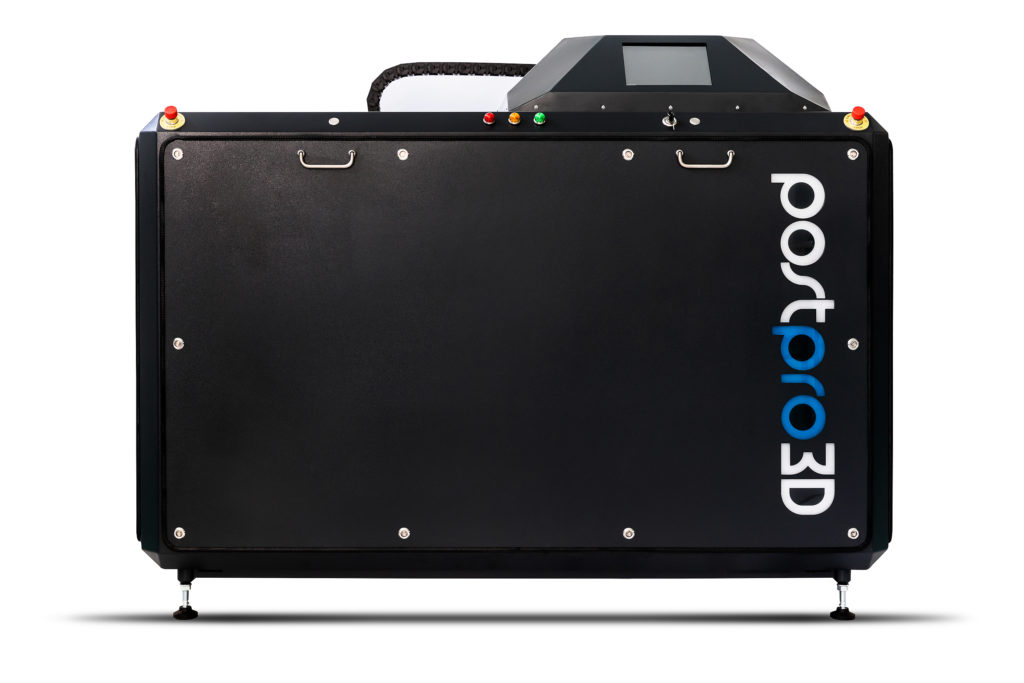The focus on effective and efficient post-processing technologies for additively manufactured production parts has become a dominant focus in the additive manufacturing (AM) space.
For many applications, the cost and time implications of post-processing are often prohibitive, usually requiring considerable human intervention which sees post-processing costs being higher than the cost of material and build.
The demand is for fully automated, safe, sustainable, and digitally-connected post-processing solutions, and it is here that Additive Manufacturing Technologies (AMT) is making its mark and unlocking the potential of AM as a true production technology.
On booth 656 at the upcoming RAPID 2019 show, 20th-23rd May, Detroit, MI, USA, AMT will be showcasing its PostPro3D system.
The event will also see the first global introduction of two new products from AMT — the PostPro3DColor and the PostPro3DMini.

Like the original PostPro3D, these systems feature the proprietary Boundary Layer Automated Smoothing Technology (BLAST) for mass production applications ranging from aerospace to footwear.
BLAST is a physio-chemical performance- and aesthetics-enhancing process that can smooth a wide variety of thermoplastic polymers, and is a non-line-of-sight process that can smooth surfaces and complex internal cavities of polymer 3D printed parts.
The process is highly controllable, allowing reproducible results with no degradation of the mechanical properties of parts. Extensive testing has demonstrated no loss in Ultimate Tensile Strength (UTS) of parts with an increase in Elongation at Break (EAB).
The increase in EAB is due to the reduction of crack initiation sites on the polymer surface due to the removal of surface porosity.
The PostPro3D hardware system is an automated post-processing solution that can achieve a surface quality equal to or better than injection moulding on parts printed using laser sintering, HP Multi Jet Fusion, high speed sintering, or fused deposition modeling technology. It achieves such surface quality through a series of pre-defined parameter sets and algorithms.
The ease-of-use and automated nature of the PostPro3D are also central characteristics of two news additions to the PostPro3D range that will be introduced at RAPID 2019, the ground-breaking and flagship PostPro3DColor and the PostPro3DMini.
The PostPro3DColor is the only commercially available post-processing equipment that can smooth and color 3D printed parts in a single step without using water and without disposable waste streams.
The PostPro3DMini offers all the advantages of the PostPro3D machine, but in a more compact unit for smaller production runs, STEM programs and design studios.
All of the PostPro3D systems reduce lead-times and overall cost of manufacture, and by so doing provide the ‘missing link’ in the digital manufacturing chain for an array of AM applications. It is an automated turnkey solution that can be easily integrated into the digital workflow and eliminates the extensive and expensive manual post-processing steps required for many 3D printed parts.
Parts processed in the PostPro3d machine exhibit no more than 0.4% dimensional change irrespective of desired surface finish, which ensures retention of fine details and the achievement of tight tolerance requirements.
Typical process time for the PostPro3D is 90 – 120 minutes, and parts are ready to use when removed from the machine, requiring no further post-processing steps.
Joseph Crabtree, CEO at AMT says: “Our BLASTT process seals the surface of the parts being processed removing porosity and thus sealing them against liquid or gas ingress. Our PostPro3D systems make part surface finishing cost and speed competitive for high volume production and has been fully tested on products across a wide range of industry sectors including automotive, aerospace, sports, and footwear.
“In addition, parts processed in the PostPro3D machines do not show a cytotoxic effect in accordance with ISO 10993-5, ISO 10993-1, and ISO 10993-12 which means they can be certified for medical use.”
He continued: “We are excited to be exhibiting and presenting for the first time at RAPID in Detroit next month. We have been operating in semi-stealth mode in the US, but our system has been commercially available for the last eight months.
“We are scaling up production both domestically in the US and globally and we are eager to share the progress we have made with our post-processing solutions. We invite anyone interested in solving their post-processing issues to come and see us at RAPID and we can arrange to post-process your samples free-of-charge.”
 Engineer News Network The ultimate online news and information resource for today’s engineer
Engineer News Network The ultimate online news and information resource for today’s engineer





